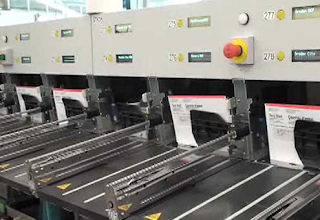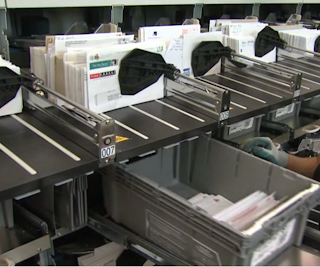
The Winnipeg Mail Processing Plant (WMPP) located near the James Armstrong Richardson Airport opened in June, 2010. The plant handles local mail from Winnipeg and from all over Manitoba. This post describes the path taken by letters as they travel through the WMPP machines.
My thanks to Mr. Eugene Knapik of Canada Post Corporation for information provided.
Edger Facer Machine
Mail from street letter boxes is brought to a work centre that combines emptying the container or bag of mail, culling out any packets or other items that are not standard letters, and feeding the mail into a machine known as an Edger Facer Machine that faces all the mail in the same orientation and direction. The facer module of the machine has an Indicia Detection System which scans both sides of the envelope to determine the orientation of the mail.
Multiple Line Optical Scanner
The mail is then processed through a Mutiple Line Optical Scanner (MLOCRs).
Mail being fed into the MLORC
The MLORCs combine several functions:
- Perform another cull of mail that cannot be processed through the machines
- Read the handwritten or printed address and sort the mail to a destination carrier
- Cancel any stamps
- Take a picture of any letter that cannot be read, spray an identifier on the envelope and transport the letter to a special stacker. This is mail for video encoding
Letters travelling through the MLOCR
The image is sent to the plant's Central Computer System (CCS).
The CCS finds the correct address block and verifies that the postal code matches the rest of the address information ( All the valid addresses in Canada exist on a database). The postal code of the address is sprayed on the front of the envelope.

If it is incorrect, the CCS corrects information wherever possible. If the address information cannot be confirmed or read, an image of the letter is sent electronically to staff in the Video Endoding System (VES) to provide a sortation decision.
Video Encoding System (VES)
Canada Post Corporation introduced the VES in 1993 at other processing plants to handle mail which could not be read by the machine. About a dozen employees work in a quiet room separate from the rest of the work floor at the WMPP. An image of the front of the letter which cannot be read by the machine is projected on a screen. The operator examines the item and enters the correct code in the computer. The information is transmitted to the MLOCR and the code determined by the VES operator is sprayed on the front of the envelope. It is possible to locate the letter in the MLOCR because a unique VES identifier code has been sprayed on the back of each letter.

VES identification code
Older model VES consoles Toronto
The VES operation can be conducted off-site. Canada Post has announced that it will be consolidating its western VES coding operations into the new Pacific Processing Centre (PPC) in Vancouver. This will be implemented on a staggered basis beginning in February 2014. The PPC will have 55 VES desks that will be used to code for Vancouver, Calgary, Edmonton, Saskatoon, Regina and Winnipeg.
Letter Sorting Machine
Letters coded by the MLOCR are then sorted in stacks by the Letter Sorting Machine. Sorted mail is removed manually and transferred to plastic bins.
Toshiba Letter Sorting Machine
Packets and Parcels
Optical Character Reader technology is also used to sort packets, small parcels and large parcels at the WMPP.











